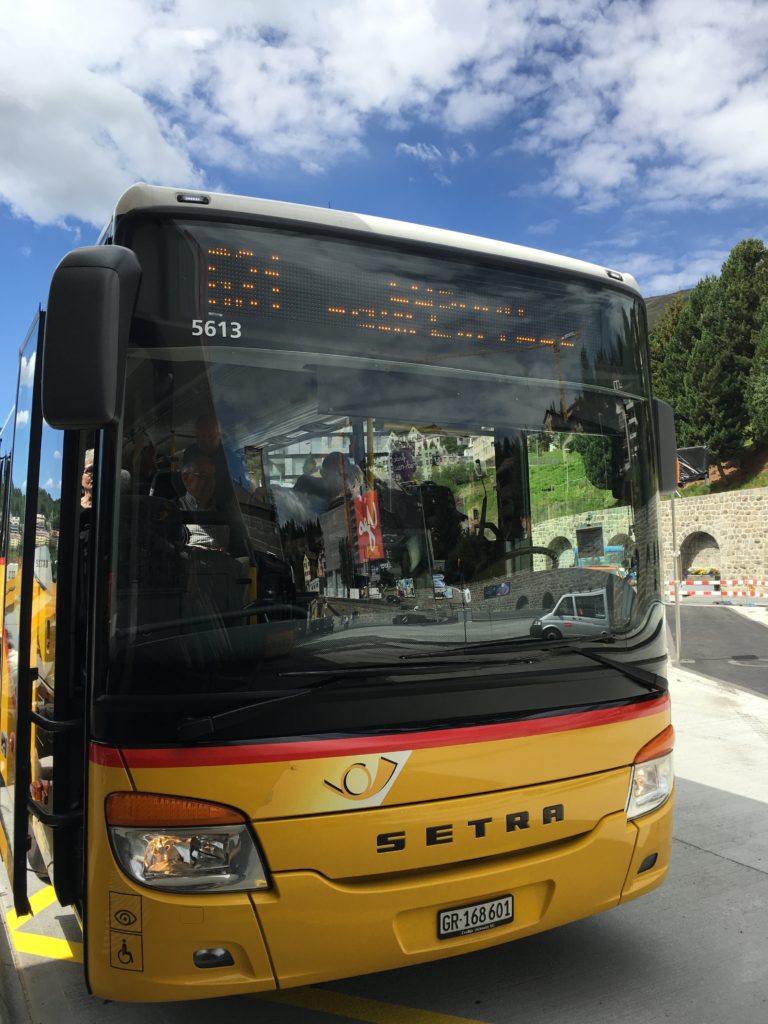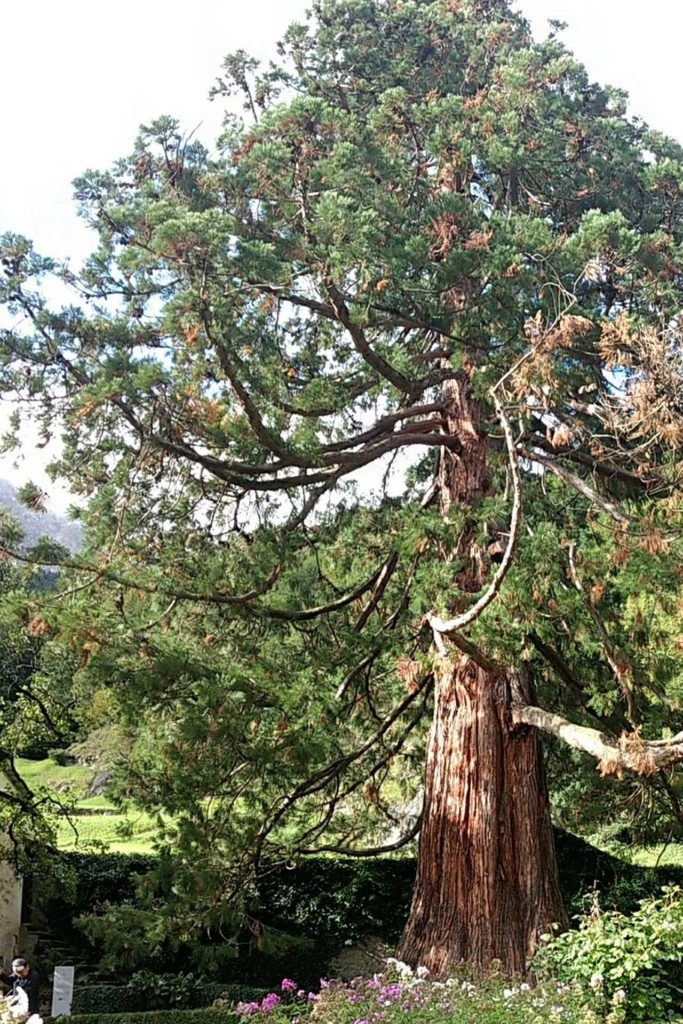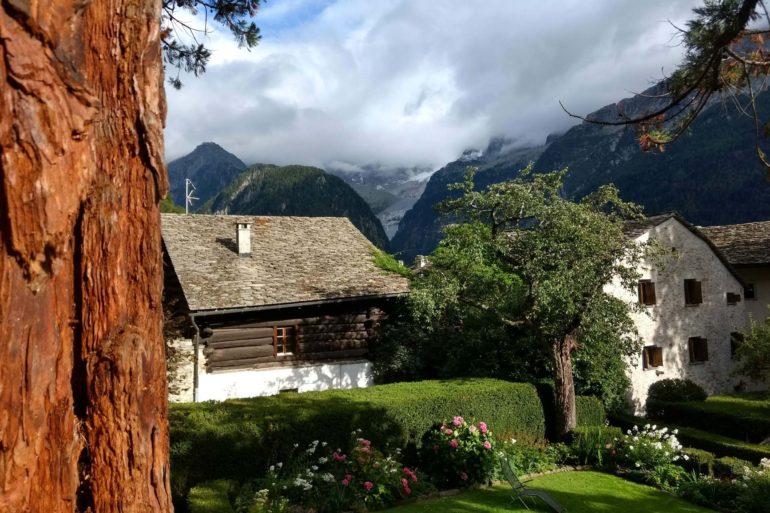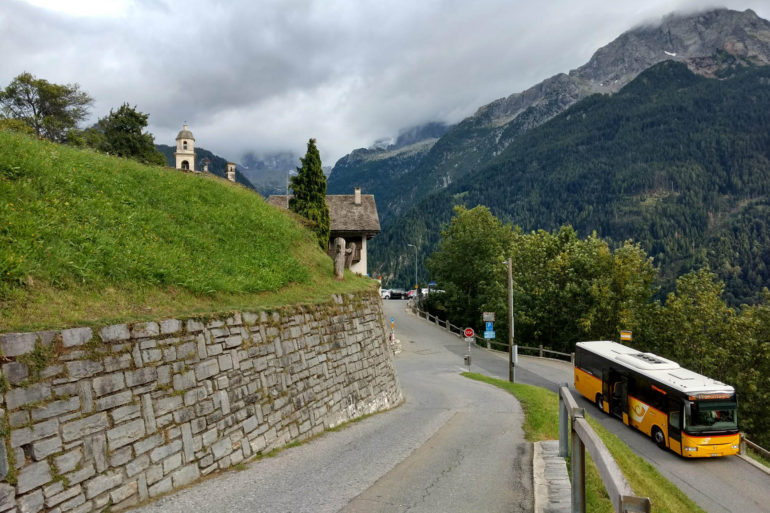Soglio is an almost impossibly charming village in the Bregaglia valley in Southeastern Switzerland. Not far from famous St Moritz and cozy Pontresina, this hidden valley and beautiful village are nonetheless firmly off the beaten path. It’s long been one of our favorite destinations and occasionally shows up as an overnight or a dayhike on our Guided Engadine tours. Soglio is one of Switzerland’s best-kept secrets, a gorgeous little village of narrow, cobblestoned alleyways and attractive houses. It sits on a high promontory overlooking the valley and gazing directly across at the handsome Piz Badile peak.
We’re not the only ones who love Soglio. It was named “Switzerland’s prettiest village” in 2015, in a survey with over 35,000 voters (it’s only gotten prettier since), and the rustic rocky architecture has a timeless quality that never grows old. You can hike from the Maloja pass through ancient hamlets shaded by leafy chestnut trees. Across the valley, the ruggedly handsome Piz Badile anchors a high rocky ridge of mountains, or you can visit by bus, a trip that is an exciting journey itself.
The Journey
You’ll visit Soglio and Val Bregaglia on a trip to the Engadine, in the far eastern corner of Switzerland tucked against Austria and Italy. The Engadine is famous for the Glacier Express, the Bernina Express, chic St Moritz and a wonderful mix of authentic culture, and snow-capped mountains. But don’t just come for the famous trains. Come to explore. Get your rail pass and come to St Moritz (remember the Glacier and Bernina Express train require a seat reservation and regularly fill in advance). If you’re coming from Zürich, you’ll take regular trains to the region that are very pretty as well. You can stay in St Moritz, you can stay in Pontresina (our preferred base for hikers), or stay somewhere along the lakes, like in the beautiful Maloja Palace hotel at the Maloja pass.

Once you’re in St Moritz, get off the train and onto the yellow Swiss postbus. This will take you on a serpentine journey along the high lakes plateau of the upper Engadine valley to the Maloja pass. Upon reaching the pass, the earth drops away below you as the bus winds down on a series of dramatic switchbacks cut into the pass west of Maloja, where the tributaries of the Inn river (and eventually the Danube) are separated from the tributaries of the Mera (and eventually the Po). This hydrological divide is fascinating from a geological standpoint, as it occurs in the middle of what from a satellite view looks like a single valley running northeast-southwest between two parallel ridges of high alpine peaks. The higher rock formations that used to divide the valley in two have eroded away, and now erosion is helping the lower elevation, south-flowing Mera to steal tributary streams (slowly in geological time) from the northeast-flowing Inn.
While the Engadine is a mix of Romansch and Germanic cultures, the Bregaglia valley is Italian-speaking, and immediately looks and feels different. The larches of the high plateau give way to chestnut trees and the white-washed sgrafitto designs of Engadine buildings are replaced by a much tighter architecture of stone and rock. The bus weaves through a number of small villages – Casaccia (a good place to start your hike… see below), Vicosoprano, Stampa, Bondo – all of which are charming. If you’re going all the way to Soglio by bus, get off at the last stop, Promontogno, to switch to another small bus that takes you up in 12 minutes to Soglio.

Hiking and Sightseeing
There are also beautiful hikes in the Bregaglia valley, and perhaps the best way to approach Soglio would be to hike there. We suggest taking the bus past the Maloja pass and getting off at the first village in the valley, Casaccia. The trail to Soglio is part of the Sentiero Panoramico, the “panoramic path”, and the views don’t disappoint. Although the trail never goes very high, you will spend most of the day well above the valley floor, on a trail with many dips and rises, crossing through meadows and broad-leaf forests. You’ll pass through a few small villages and past many crumbling farms on your way to Soglio. You should bring a picnic lunch for the day, and stop at one of the many attractive viewpoints for lunch.
The trail starts from the post office in Casaccia, and is signposted to Roticcio, Durbegia, Parlongh and Soglio. The trail takes you through a meadow, past a small reservoir, and contours just above the floor of the valley to the small village of Roticcio. You’ll walk straight through the village, turning right at the signposted turn up a small alley to leave town.

You’ll start rising now through the woods, crossing a number of streams as the valley drops away below. About an hour after leaving Roticcio, you’ll reach a small alp farm at Durbegia, where there is a small restaurant serving drinks – the only possibility for refreshments on the way to Soglio. Continue along through the woods, eventually dropping to a trail junction at Parlongh, and keep straight on the signposted trail to Soglio. In many parts here the trail is paved with large stones. Finally, you’ll turn a corner and see the village of Soglio nestled below you.

The return to Sils Maria is also by bus, and takes just over an hour. You’ll take a bus from Soglio to Promontogno at the bottom of the valley, and then another bus from there to St Moritz.
A Day in Soglio
The Palazzo Salis is a fabulous hotel in Soglio, and one that is entirely in keeping with the medieval nature of the town. Originally built by a knight in 1630, this former palace still sports weapons and suits of armor in the hallways. They have atmospheric rooms, great meals, and an incredibly relaxing garden. It’s worth a stop. For this blog series, we sent one of our guides, Jimmy Marshment-Howell, on a scouting trip to learn the area. Jimmy is a forester by training and took a keen interest in the flora and fauna of the region. Here is his day in Soglio…

There are three sequoias that I know of in Soglio. Two are in the garden at Palazzo Salis, and one is across from the bus stop, leaning out over a stone and concrete wall. That one is younger, maybe 80, maybe 60. Maybe 100. Apparently, they were planted all across Europe in the 1800’s in the yards of noble families, gifted by British nobles from their gardens, who in turn had received seeds from North America via the plant collectors William Lobb (an Englishman) and J. Matthew (a Scotsman).
The two in the garden are massive, ancient creatures. One is burnt, and apparently both suffer from a fungus. Unclear if the burn marks were the cancer or an attempt at a cure. The other is giant, a prime example of the species, vigorous and rotund in its young adulthood at 300+. It may be 60 meters tall. I heard a man who had been raking leaves among the lounge chairs on a section of lawn, his (perhaps) wife, and an interested older lady who had been making the rounds photographing the garden with her smartphone discussing how regrettably, they would be cut down.

“If it were up to us, of course…” remarked the gardener, qualifying his inclination with “but I am not the owner.”
“A shame,” said the older woman.
“Well,” said the man “They’ve wanted to cut it for 60 years. It wouldn’t even hurt anything if it DID fall…”
His wife: “and an arborist looked at it and said it was quite healthy, no danger of it falling. The roots go practically across the garden to the hotel.”
The man: “The branches though, of course, are another thing. That one for example…”
The older woman “of course, but that’s understandable. Such an old tree! Even the other one, it doesn’t look so sick, really…”

This all transpired in the golden moments on a day I had begun in the rain, snow, and sleet as the storms were finally lifting and the last rays of the evening were giving our little village a breath of hope for good weather tomorrow. I sat up in a replica tree stand made as an art project. It leans against the sickly sequoia, climb at your own risk. The photos I was compelled to keep snapping caught the best light. It’s just that perfect time of day, with the perfect amount of cloud cover. I’m cursing myself for once again neglecting to fix my Grandpa Bob’s camera, 35mm Pentax. Grit from Africa got into some gear, and mysterious metal shavings started to appear whenever I changed lenses. This was right after Africa, when I had borrowed $100 from Andrew to buy another month’s worth of chapatis, avocados, tomatoes, and Tusker. Couldn’t afford to fix it. Now I could get a DSLR body for the lenses, maybe. I have dozens of unexposed rolls of film stockpiled. Can I even get it developed anymore? I guess I could do it myself at least, with the black and white anyhow… Oh well. The phone is fine really, although I only got one good shot of the dozens of extremely photogenic cats I saw walking back to town.
It’s not that I dislike Pontresina, or St. Moritz. I recognize that they are beautiful and nice, et cetera. You just don’t get this light there though. Not with the cats, not with the trees, not with the incredible eavesdropping. Not with the waterfall outside the village, scoured – must have been recently – with a terrifying force into the granitic bedrock.
I have been traveling alone now for several days through the Engadine valley in Switzerland looking for a place like this. Troy finds them. He nailed it with Guarda, and now with Soglio. I think we need to find something in the middle. There was a moment in the MMB funicular (Muottas Muragl, near Pontresina) with the two little boys and their father saying ‘Now… now. NOW. Now? NOW!! NOW? Now now now now NOW!’ in anticipation of the odd vehicle departing. Giggling.
As we rose up through the rain into the snow, again. Then there was, lunch, at the Alp Languard- Porcini tagliatelle with a dark beer from the local brewery to wash it down. Maybe six other hardy mountain people were in the empty restaurant. Authenticity is a moving target. You feel it though. I am getting bored with the merely beautiful. I want that good deep rich authenticity. I want the conversation, or the light, or the taste, or the sound of the place that feels like it is for me, for us, that resonates with me and brings me closer to the land I’m walking on.
People come towards that like moths to light, flapping, staggering. Lurching towards the nice places, the beautiful views. The locals probably hate it. But they mostly live from it here, now. And of course, they always have places hidden so deep, moments so fleeting or out of the way that we couldn’t hope to touch them in a few days. It would take seasons, decades.. or the most unbelievable stroke of luck and timing.
I talked to the owner/proprietor of the Palazzo Salis the next morning. There is a ‘Hallimasch Pilz’ (Armillaria mellea s.l.), a mushroom that infects the root systems of Sequoias (especially when they are under some other sort of stress, for example drought or low temperatures). They may have to be cut down soon to prevent damage to life or property.




Beyond the Guidebook





